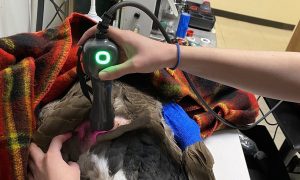New laser helps center treat injured native wildlife
January 7, 2021
The laser improves blood flow and circulation; decreases inflammation, swelling, and edema; and helps reparative cells, such as fibroblasts, reach affected areas. It can also be an additional source of pain relief. (Photo courtesy of Willowbrook Wildlife Center)
DuPage Forest Preserve District’s Willowbrook Wildlife Center in Glen Ellyn is providing its native wildlife patients with innovative pain relief thanks to a new therapeutic laser purchased with an estate gift from a Glen Ellyn man.
Willowbrook staff have been using the laser equipment on patients on a daily basis since receiving it Dec. 9, according to Dr. Sarah Reich, staff veterinarian and wildlife rehabilitation and research manager at Willowbrook. The laser, also known as a cold laser or low-level laser, provides pain relief and stimulates tissue healing and regeneration.
“In our experience and research, laser therapy can improve patient care and increase the speed of healing, so we are excited to be able to add this to our treatment protocol,” Reich said.
Purchase of the new $22,200 equipment was made possible thanks to a generous estate gift from longtime Glen Ellyn resident Ron Bork, who established a nearly $1 million fund for animal welfare projects through the DuPage Foundation.
The fund is being distributed over five years (2018 – 2022), with half of the annual donation supporting Willowbrook Wildlife Center through the Friends of the Forest Preserve District of DuPage County and half supporting other local agencies.
“The No. 1 goal in our rehabilitation process is to return wild animals to their native environments,” Reich said. “Anything we can do to decrease their time with us is a win. We are constantly trying to improve the treatment of our patients, so we are thrilled to now be able to provide such an advanced level of care.”
The laser light is absorbed by specific cells in the body in a process called photobiomodulation. The laser improves blood flow and circulation; decreases inflammation, swelling, and edema; and helps reparative cells, such as fibroblasts, reach affected areas. It can also be an additional source of pain relief.
“Generally, almost any type of trauma or inflammation could benefit from laser therapy,” Reich said.
It’s already helped Willowbrook care for patients.
“The majority of our injured and sick wildlife patients present with some level of trauma or inflammation, which means they could benefit from laser therapy,” Reich said. “Currently we have two patients that underwent surgical repair of multiple bone fractures that are receiving weekly laser therapy sessions in conjunction with their recheck X-rays.
“Our hope is that now all of our post-operative cases will receive laser therapy during their physical therapy or recheck sessions,” Reich said.
Willowbrook recently admitted a great horned owl that was found entangled in a soccer net hanging from its wing for an extended period of time. In addition to medications and topical therapy, daily laser therapy was provided to encourage blood flow and recovery of the wing. Just 24 hours after the first session, the wing was significantly improved, and a week later the wing appeared normal and the bird was moved outside.
“This is a surprisingly fast turnaround for this type of injury and the laser likely had a great deal to do with it,” Reich said.
Laser therapy has become a common therapeutic tool in human and veterinary medicine, but high-quality equipment backed by research is cost-prohibitive to many wildlife rehabilitation centers, Reich said.
“We expect to see our wound cases heal more rapidly, our orthopedic cases return to function more quickly, and our patients display more comfort and fewer indications of pain,” Reich said. “As we track the use of the laser, it will be interesting to review the healing success of cases over the next year to our previous results and see if there’s a noticeable difference.”
In 2020 Willowbrook treated more than 9,000 birds, mammals, reptiles, and amphibians. It is the only publicly funded wildlife rehabilitation facility in DuPage County and one of the few in northeastern Illinois equipped to treat native and migratory birds.



